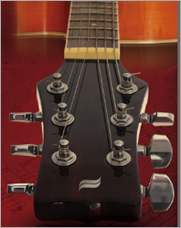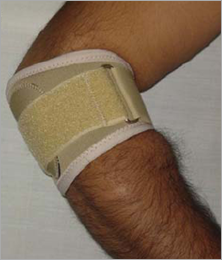Lateral epicondylitis, or tennis elbow, is one of my least favorite injuries. It can be disabling, nagging, and sometimes even relentless! A commonly recommended treatment involves the use of a tennis elbow strap. There has been some support in the literature regarding these orthotics, however results in the literature have varied.
A nice new study published in a recent issue of JOSPT assessed the efficacy of these devices in a group of 52 subjects with lateral epicondylitis. The study examined the amount of pain-free grip strength and maximum grip strength is subjects with a variety of tennis elbow straps, including a placebo strap.
How Do Tennis Elbow Straps Work?
 The theory behind counter-force bracing is similar to the mechanics of a guitar. When a finger is placed on a string along the neck of the guitar, it reduces tension on the string distal to the fret where your fingers are located. A counter-force tennis elbow strap can be thought of as your fingers on the neck of the guitar (your forearm) and the extensor muscles, especially the extensor carpi radialis brevis, would be the guitar string, thus reducing tension of the muscles as they attach to the lateral epicondyle. The authors of the study review this concept well.
The theory behind counter-force bracing is similar to the mechanics of a guitar. When a finger is placed on a string along the neck of the guitar, it reduces tension on the string distal to the fret where your fingers are located. A counter-force tennis elbow strap can be thought of as your fingers on the neck of the guitar (your forearm) and the extensor muscles, especially the extensor carpi radialis brevis, would be the guitar string, thus reducing tension of the muscles as they attach to the lateral epicondyle. The authors of the study review this concept well.
Counter-force Bracing is Effective
Results indicate that strapping was effective in allowing subjects to produce significantly more pain-free force. Subjects were able to produce 16% more strength without pain using a strap. There was no difference between two of the devices they used (a strap vs. a sleeve with a built in strap), indicating the strap itself is likely the significant factor. The image below on the left is just the strap and the image on the right is the sleeve with a built in strap:


One of my original concerns with the study involved the rest time between repetitions of grip strength. As anyone that routinely assesses grip strength knows, the amount of force produced can drop significantly if the rest time between repetitions is not adequate. However, the study design used a mean of 4 repetitions for each device and allowed 5 minutes of rest between testing sessions. This was adequate for me and I was happy to see this methodology.
Clinical Implications
- I like this study because bracing is simple, cheap, and effective. People can go to any CVS or Target and get a nice tennis elbow strap these days.
- Counter-force tennis elbow straps are effective at allowing patients with lateral epicondylitis to produce more grip strength with less pain.
- The strap should be placed around 2.5 cm distal to the lateral epicondyle.
- While it is unclear if the size of the strap is important, the study used straps that were between 5-8cm in width. Considering there is some conflicting results in the literature, I would recommend you try to replicate the width of the strap. There are some straps on the market that are very skinny.
- Straps can be an effective way to allow people with lateral epicondyltis to return to athletics or weight lifting when painful gripping can severely limit activities.
Fahimeh Sadat Jafarian, Ebrahim Sadeghi Demneh, Sarah F. Tyson (2009). The Immediate Effect of Orthotic Management on Grip Strength of Patients With Lateral Epicondylosis J Orthop Sports Phys
Sign up for my FREE newsletter for even more great content!




